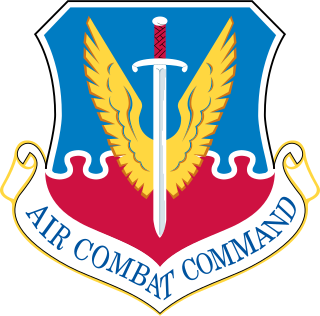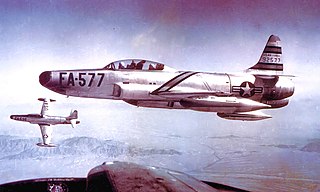
The Air Combat Command (ACC) is one of nine Major Commands (MAJCOMs) in the United States Air Force, reporting to Headquarters, United States Air Force (HAF) at the Pentagon. It is the primary provider of air combat forces for the Air Force, and it is the direct successor to Tactical Air Command. Air Combat Command is headquartered at Langley Air Force Base, Joint Base Langley–Eustis, Virginia, United States.

The Sixteenth Air Force (Air Forces Cyber) (16 AF) is a United States Air Force (USAF) organization responsible for information warfare, which encompasses intelligence gathering and analysis, surveillance, reconnaissance, cyber warfare and electronic warfare operations. Its headquarters is at Joint Base San Antonio-Lackland in Texas.

The Central Security Service (CSS) is a combat support agency of the United States Department of Defense which was established in 1972 to integrate the National Security Agency (NSA) and the Service Cryptologic Components (SCC) of the United States Armed Forces in the field of signals intelligence, cryptology, and information assurance at the tactical level. In 2002, the CSS had approximately 25,000 uniformed members. It is part of the United States Intelligence Community.

The Air Force Materiel Command (AFMC) is a Major Command (MAJCOM) of the United States Air Force (USAF). AFMC was created on July 1, 1992, through the amalgamation of the former Air Force Logistics Command (AFLC) and the former Air Force Systems Command (AFSC).

The 557th Weather Wing is a United States Air Force formation and its lead military meteorology center. It reports environmental situational awareness worldwide to the Air Force, the United States Army, joint warfighters, Unified Combatant Commands, the national intelligence community, and the Secretary of Defense. It is headquartered at Offutt Air Force Base, in Bellevue, Nebraska.

The 67th Cyberspace Operations Group is a unit of the 67th Cyberspace Wing. Headquartered on Kelly Field Annex's Security Hill, the group is an Air Force information operations unit.

The 175th Wing is a unit of the Maryland Air National Guard, stationed at Warfield Air National Guard Base, Middle River, Maryland. If activated to federal service, components of the Wing are gained by the two separate major commands of the United States Air Force: Air Combat Command (ACC) and United States Air Forces in Europe (USAFE).

The United States Air Force's 688th Cyberspace Wing is a cyberspace operations unit located at Kelly Field Annex, Joint Base San Antonio-Lackland, Texas. It was first organized in July 1953 as the Air Force Special Communications Center. It produced long term intelligence information and developed intelligence gathering techniques. Losing its communications intelligence functions, it focused on electronic warfare, and in July 1975 was redesignated the Air Force Electronic Warfare Center. As its mission grew to include all elements of the spectrum, it became the Air Force Information Warfare Center in September 1993 and the Air Force Information Operations Center in October 2006. In 2009, it was reassigned from the intelligence community to Air Combat Command and became the 688th Information Operations Wing, assuming its current name in September 2013.

Twenty-Fourth Air Force / Air Forces Cyber (AFCYBER) was a Numbered Air Force within the United States Air Force. The Air Force consolidated its cyberspace combat and support forces into 24 AF. 24 AF was the Air Force component of U.S. Cyber Command.

The United States Air Force Warfare Center (USAFWC) at Nellis Air Force Base, Nevada, reports directly to Air Combat Command. The center was founded on 1 September 1966, as the U.S. Air Force Tactical Fighter Weapons Center. It was renamed the U.S. Air Force Warfare Center in 2005.

The IX Fighter Command was a United States Army Air Forces formation. Its last assignment was with the Ninth Air Force, based at Erlangen, Germany, where it was inactivated on 16 November 1945.

The Air Force Command and Control Integration Center was an Air Combat Command field operating agency responsible for innovating, designing, developing, integrating, and sustaining command and control capabilities. It was a tenant unit at Langley Air Force Base, with several outlying support locations.

The 92d Cyberspace Operations Squadron is a United States Air Force unit.

The 567th Cyberspace Operations Group is a United States Air Force organization at Joint Base San Antonio-Lackland, Texas, assigned to the 67th Cyberspace Wing. It was activated in June 2018.

The 318th Cyberspace Operations Group is a United States Air Force information operations unit located at Joint Base San Antonio, Texas. The group was first activated during World War II as the 8th Photographic Reconnaissance Group. After training in the United States, the unit moved to the China-Burma-India Theater and engaged in hostilities until the end of the war. It returned to the United States in November 1945, and was inactivated at the port of embarkation.

The 689th Combat Communications Wing was a wing of the United States Air Force stationed at Robins Air Force Base, Georgia. The wing was activated on 9 October 2009 as a subordinate unit of Twenty-Fourth Air Force. On 5 June 2013, the wing was inactivated, along with the 3d Combat Communications Group at Tinker Air Force Base, Oklahoma. The 5th Combat Communications Group at Robins now reports to the 688th Cyberspace Wing.

Twenty-Fifth Air Force, was a numbered air force (NAF) within the United States Air Force (USAF), and served as the Air Force's premier military intelligence organization. 25 AF was established on 29 September 2014 by redesignating the Air Force Intelligence, Surveillance and Reconnaissance Agency under Headquarters, United States Air Force, to a numbered air force aligned under Air Combat Command. The USAF also realigned the 9th Reconnaissance Wing and the 55th Wing under the new NAF. It was headquartered at Lackland Air Force Base, Texas.
The 26th Network Operations Squadron, United States Air Force, is a network operations unit located at Gunter Annex, in Montgomery, AL.



















